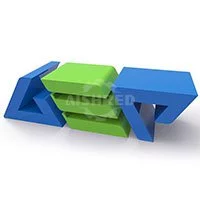The efficient processing of cardboard and wood materials is crucial in various industries. This paper aims to optimize the performance of a single-shaft shredder for handling both cardboard and wood through a combination of parameter adjustments and material preparation techniques. By identifying the key factors that affect shredding efficiency and implementing appropriate solutions, this study seeks to improve overall productivity and reduce operational costs.

1.Introduction
The recycling and reprocessing of cardboard and wood materials play a significant role in waste management and resource conservation. Single-shaft shredders are commonly used in these operations due to their versatility and cost-effectiveness. However, achieving optimal performance requires careful consideration of several factors, including shredder parameter adjustments and material characteristics.
2.Shredder Parameter Optimization
2.1. Knife Configuration: Selecting the appropriate knife configuration is crucial for efficient shredding. Different materials have varying densities and structural properties, necessitating the use of specific knife geometries. For example, a higher number of teeth on the shredder blade might be required to shred harder materials like wood, while fewer teeth might be suitable for cardboard.
2.2. Speed and Torque Adjustment: Fine-tuning the shredder’s rotational speed and torque settings can significantly impact processing efficiency. Higher speeds and torque can result in faster shredding, but excessive speeds may lead to increased wear and tear on the machine. Finding the right balance based on the materials being processed is essential for maximizing throughput and minimizing energy consumption.
3.Material Preparation Techniques
3.1. Size Reduction: Pre-reducing the size of cardboard and wood materials before shredding can enhance overall processing efficiency. This can be achieved through mechanical chopping or breaking processes, allowing the shredder to handle smaller and more uniform feedstock. Smaller particle size reduces the load on the shredder and facilitates smoother material flow.
3.2. Moisture Control: Proper moisture content in the materials can significantly affect shredding performance. Excessive moisture can make the materials sticky and difficult to process, while extremely dry materials may become brittle and result in inefficient shredding. Maintaining an optimal moisture range for both cardboard and wood enhances the shredder’s effectiveness.
4.Testing and Evaluation
To validate the proposed optimization strategies, a series of tests should be conducted using different combinations of shredder parameters and feedstock preparation techniques. Shredding efficiency can be assessed by measuring throughput, energy consumption, and particle size distribution. Real-time monitoring of various operational parameters can provide valuable insights into the shredder’s performance.
5.Results and Discussion
Based on the experimental results, the optimized shredder parameters and material preparation techniques can be identified. The findings can be compared with the initial performance of the shredder, demonstrating the improvement achieved in terms of processing efficiency, particle size uniformity, and overall productivity.
Optimizing a single-shaft shredder for processing cardboard and wood requires adjustments to shredder parameters and material preparation techniques. By selecting the appropriate knife configuration, fine-tuning speed and torque settings, reducing particle size, and controlling moisture content, significant improvements in shredding efficiency can be achieved. Implementation of these optimization strategies can enhance overall productivity, reduce operational costs, and promote sustainable waste management practices in various industries.

